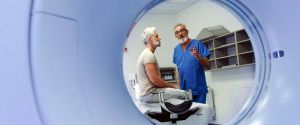HLTH 2026 was a packed week, and radiology had a major place in the conversation. Thinking around artificial intelligence in radiology has matured. No longer driven only by curiosity or fear, it is now centered on practical results, patient safety, and the enduring value of human expertise.
At the center of this evolution was the announcement of HLTH.rad, a new global event launching in Amsterdam next June. HLTH.rad will bring together radiologists, AI developers, and healthcare leaders to explore how imaging continues to transform diagnosis and care delivery. The topics—AI-driven diagnostics, quantum imaging, and precision medicine—reflect a field that is not only innovating rapidly but also learning to balance ambition with accountability. The focus is clear: how can technology truly make a difference for patients, clinicians, and the systems that support them?
AI Beyond the Hype
Throughout HLTH 2026, one theme echoed across sessions: moving from hype to impact. The novelty of AI has worn off. The question now is not can AI do it, but how well it fits into clinical reality. We heard powerful examples of AI improving speed to care, patient engagement, and clinician cognitive load.
These advancements are examples of real tools shaping everyday workflows. Deep learning models are already catching subtle signs of early-stage cancers, and AI “second reads” are being used as safety checks for complex imaging cases. The outcomes are tangible: faster turnaround times, fewer errors, and more consistent quality of care.
But walking the show floor, it is clear that the emphasis on outcomes hasn’t made it to the marketing and sales departments. AI is a tool, not a strategy. To every vendor out there who believes selling “AI” is the path to growth, it’s not. The only way to gain market share is by delivering something genuinely valuable: something that drives patient outcomes, improves clinicians’ lives, and advances care. There’s still plenty of money flowing toward AI in healthcare—but to what end? Have we, as an industry, lost our mooring to healthcare’s actual goal?
The things that make a solution valuable haven’t changed. Stop selling AI. Start showing results. Go beyond performance metrics—show authentic outcomes, told in the voices of patients and providers.
Human-Centered Intelligence
In my own work and across our field, we continue to push back against the false narrative of AI replacement. The idea that algorithms will make radiologists obsolete misses the point entirely. The most powerful AI systems are those that extend human capability, not erase it.
Radiology has seen this story before. When Picture Archiving and Communication Systems (PACS) were first introduced, many feared the end of radiology as they knew it. Instead, PACS made radiology more efficient, standardized, and accessible—and imaging volumes exploded as a result. The same pattern is unfolding with AI. Automation increases throughput, but demand for expertise continues to grow.
AI doesn’t remove the radiologist from the workflow—it changes where and how radiologists add value. By automating repetitive steps, AI allows radiologists to spend more time interpreting results, communicating with clinicians, and engaging with patients. This shift transforms the role from technical executor to strategic decision-maker. This is what we mean when we say “human-in-the-loop.”
Collaboration as the New Competitive Advantage
Another defining feature of HLTH 2026 was the growing recognition that meaningful AI adoption cannot happen in silos. The most successful examples came from partnerships that brought together hospitals, AI companies, and regulatory bodies to co-design solutions from the ground up.
This collaborative model allows for transparency and shared accountability. When clinicians are involved early, they shape algorithms that mirror real-world challenges. When engineers work alongside them, they build systems that actually fit into the workflow. And when regulators and payers are part of the conversation, innovation moves faster and safer.
The Bottom Line
Leaving HLTH 2026, one sentiment resonated above all: we are entering an era of augmented intelligence, not artificial replacement. The systems that will thrive are those that are built around people—clinicians, patients, and caregivers alike.
AI progress depends on humility as much as innovation. We must continue to measure, validate, and iterate. We must ensure that every algorithm strengthens trust, not undermines it. And we must never lose sight of why we started this journey—to make care safer, more accessible, and more human.
Radiology once again stands on the front lines of transformation. Just as it led the shift to digital imaging, it now leads the integration of intelligent systems. The path forward will not be defined by who builds the smartest model, but by who builds the most meaningful one.
Because the future of AI in healthcare will not be written by machines. It will be shaped by the people who use them—with compassion, curiosity, and the courage to keep improving.
And one last observation: sport blazers are the new puffy vests.












